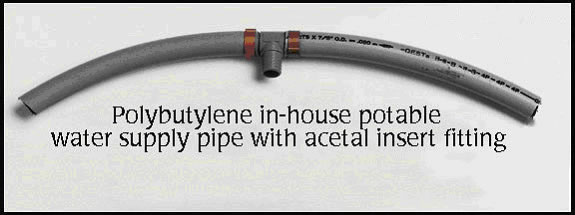During a home inspection in Mesa our inspector noticed that the electrical panel had the notation “non-metallic piping system”. This is clue number one. While the home inspector in Mesa was in the attic the attic he spots grey colored piping. This is clue number tow and a confirmation. Our Mesa home inspector has discovered polybutelene piping used for the water supply for the home.
Homebuyers often raise concerns over the presence of polybutylene pipe (PB) in their prospective home. PB piping has received a significant volume of bad press due to a relatively large number of leak incidents. Lawsuits abound against manufacturers of PB piping systems.

Introduced in the late 1970’s, PB has been used to pipe approximately six million homes in the U.S. It is unclear how many homes in Arizona have PB because it is often very difficult to identify by visual inspection, as stubs to sinks and toilets generally use poly-to-copper connectors. The average costs for PB related home repairs are about $4,000 according to industry experts. In some cases homeowners are finding that homeowners insurance companies will either cancel their coverage when PB causes extensive damage or refuse coverage to homes piped with PB.
The primary cause of failures is leaking at fittings and joints. On rare occasions the piping itself may develop leaks (the cause of piping leaks is not fully understood). PB piping remains popular among many homebuilders because it offers savings of $200 to $600 per home compared to C-PVC and copper piping. The cost savings result from lower installation costs — PB can be installed quickly by semi-skilled labor. Introduced in the late 1970’s, PB has been used to pipe approximately six million homes in the U.S. It is unclear how many homes in Arizona have PB because it is often very difficult to identify by visual inspection, as stubs to sinks and toilets generally use poly-to-copper connectors. The average costs for PB related home repairs are about $4,000 according to industry experts. In some cases homeowners are finding that homeowners insurance companies will either cancel their coverage when PB causes extensive damage or refuse coverage to homes piped with PB.
To share a few tips on how experienced home inspectors try to identify polybutelene piping, look to the following:
· If the home has a plastic piping system, a designation like “Non-Metallic Plumbing System” is supposed to be permanently written in the building electrical panel. Sometimes it is, sometimes it isn’t.
· Often homes that have polybutelene piping also have a pressure regulator installed. While not conclusive, this can be an indicator.
· In the attic you have the best chance of seeing the piping system. If the insulation does not fully cover the piping it may be visible as a blue or grey plastic piping.
· Supply valve areas at individual fixtures are often loose at the wall in polybutelene systems. Give the piping a gentle pull to see if the piping is secured or loose. With experience you can often determine if the system is plastic or a more rigid metallic piping system.
Caution seems to be the final word with regard to PB use. Buyers still need to beware of the increased potential for leaking in a home piped in PB. For more information on PB piping check out http://www.polybutylene.com/test.html or call the Plumbing Claims Group at (800) 356-3496.

